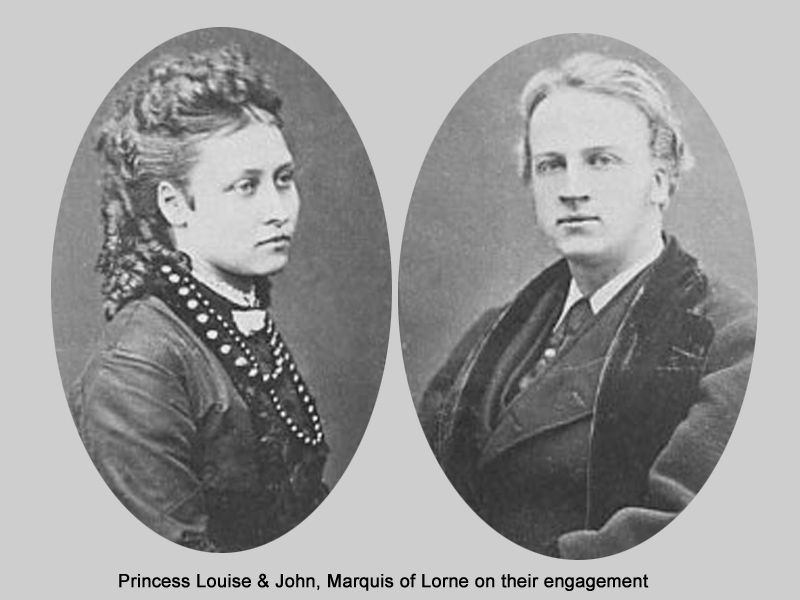A Royal Marriage
The wedding between Princess Louise, sixth child of Queen Victoria, and John Douglas Sutherland Campbell, Marquis of Lorne took place on Tuesday 21 March 1871.
They had become engaged on 3 October 1870 at Balmoral Castle, Scotland. John was heir to the Dukedom of Argyll, and son of George Campbell, the eighth Duke of Argyll.
The ceremony took place at St George’s Chapel, Windsor Castle. A large crowd gathered and for the first time the policemen had to form barriers to hold them back.
Princess Louise wore a veil of Honiton lace she had designed herself and was escorted by her mother and two eldest brothers, the Prince of Wales and the Duke of Edinburgh. The 91st Argyllshire Highlanders provided a Guard of Honour with their band and pipers.
A short honeymoon was spent in Claremont, Surrey
CELEBRATIONS IN RYDE
The wedding day was celebrated in Ryde with a public holiday and a procession through the town.
THE APPROACHING ROYAL MARRIAGE – At a town’s meeting held at Ryde on Monday, the Mayor presiding, it was resolved to observe the day of the Princess Louise’s marriage as a public holiday, and to give a tea to the school children. An amendment moved by the Rev C Staning, to the effect that the celebration be deferred until after Easter, was greeted with hisses, and was not seconded.
Source: Lloyds Weekly Newspaper, London Sunday 19 March 1871, Issue 1478
THE ROYAL MARRIAGE – The marriage of the Princess Louise and the Marquis of Lorne, on Tuesday, was very heartily celebrated at Ryde. The principal streets of the town were gaily decorated with flags, the pier was all ablaze with bunting, and the flag staves at the preventative station and at the Royal Victoria Yacht Club House were profusely dressed. After dark the Town Hall was illuminated. At noon the Town Council held a special meeting at the Town Hall, to agree to an address of congratulation to Her Majesty, the Queen on the marriage of HRH, the Princess Louise with the Marquis of Lorne. – The motion was proposed by the mayor (Mr Alderman E Thurlow), and seconded by Mr White, “the only bachelor who had received the confidence of the burgesses, who now included ladies as well as gentlemen.” It was carried by acclamation. – The mayor then invited the council to drink health, long life, and happiness to the newly wedded pair, in a bumper of champagne. He afterwards, in responding to the town of his own health, thanked all the inhabitants of the town for the way in which they had responded to his appeal to decorate the borough. He hoped that all spend a happy day. A procession was formed at the Town Hall, composed of the band of the Isle of Wight Rifle Volunteers, the Coastguardsmen of Ryde Station, the 1st Isle of Wight Rifle Volunteer Corps, the children of the various schools, viz. The National School, George Street Congregational School, Nelson Street Wesleyan School, the Band of Hope band, St James’s School, Star Street Primitive Methodist School, Holy Trinity School, St Marie’s Roman Catholic School, Christchurch Baptist School, High Street and Swanmore Free Wesleyan Schools, Newport Street Bible Christian School, children not attending schools, band, the Friendly Societies, viz. :- The Ryde Branch of the Hampshire Friendly Society, the Loyal East Medina Lodge of the Independent Order of Oddfellows, Court Astraea of the Ancient Order of Foresters, The Lifeboat and Crew, Mr Southcott, coxswain, the Borough Fire Engine, the Fire Brigade, Infants belonging to schools in waggons. The procession marched through St Thomas’s Square, Cross Street, Melville Street, Monkton Street, Wood Street, Barfield into Star Street, Star Street to High Street, up High Street to Green Street, through Green Street to Upper West Street, along Upper West Street, down John Street, High Street, and Union Street, and through Pier Street, to the Esplanade, where it halted. On the Esplanade the children sang “God save the Queen”, accompanied by the bands, after which the Mayor called for three cheers for the happy pair, which were given in a style that made “the welkin ring”. The schools and the societies then left the Esplanade for their respective places of meeting. After the procession all the school children were provided with tea at their respective schoolrooms. The old people were afterwards treated to a knife and fork tea at the Town Hall. A number of inhabitants dined together at the Pier Hotel, under the chairmanship of the Mayor, and other festivities took place.
Source: Hampshire Telegraph and Sussex Chronicle Saturday 25 March 1871, Issue 4028

